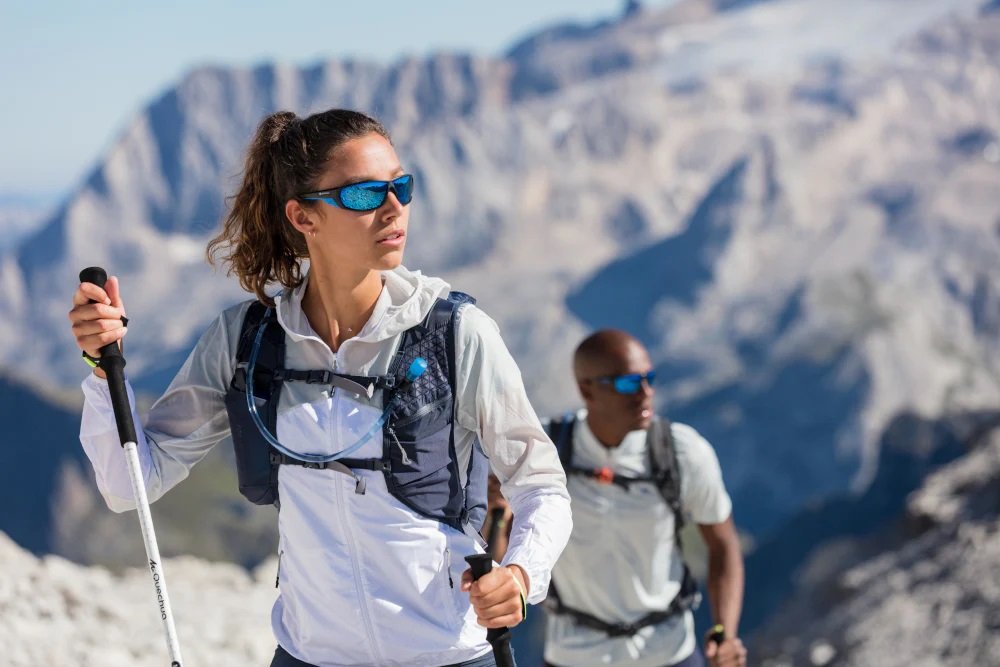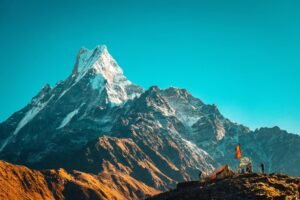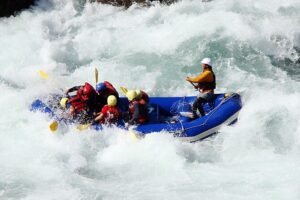Mountaineering is a thrilling pursuit that attracts adventurers worldwide. The allure of conquering high peaks comes with significant challenges and risks, including the threat of eye damage due to exposure to intense ultraviolet (UV) radiation at high altitudes. The higher you ascend, the more vulnerable your eyes become to harmful UV rays and the harsh glare of the sun reflected off snow and ice. This comprehensive guide delves into the importance of mountaineering sunglasses, key features to look for, top models available, and tips for selecting the right pair to protect your eyes in extreme conditions.
The Importance of Mountaineering Sunglasses
Why Eye Protection is Crucial at High Altitudes
Mountaineering sunglasses are not merely a fashion accessory; they are essential for safeguarding your eyes from several unique hazards encountered in high altitude environments:
- Increased UV Radiation: As altitude increases, the atmosphere thins and becomes less effective at filtering UV radiation. For example, at 10,000 feet, UV levels are approximately 50% higher than at sea level.
- Snow Blindness: Reflective surfaces like snow and ice can reflect up to 80% of UV rays, causing photokeratitis, also known as snow blindness. This painful condition is akin to a sunburn on your eyes and can temporarily impair vision.
- Intense Glare: The glare from the sun can cause eye strain, discomfort, and decreased visibility. This is particularly dangerous when navigating challenging terrains.
- Wind and Debris: High Altitude winds can carry fine particles of ice, snow, and dirt that can irritate or damage your eyes.
Health Consequences of Inadequate Eye Protection
Failing to protect your eyes adequately can lead to both shortterm and longterm health consequences:
Photokeratitis: This painful condition can cause redness, tearing, and a gritty sensation in the eyes, temporarily blinding mountaineers.
Cataracts: Prolonged exposure to UV rays can accelerate the development of cataracts, a cloud
Mountaineering Sunglasses: Protecting Your Eyes at High Altitudes
Mountaineering is a thrilling pursuit that attracts adventurers worldwide. The allure of conquering high peaks comes with significant challenges and risks, including the threat of eye damage due to exposure to intense ultraviolet (UV) radiation at high altitudes. The higher you ascend, the more vulnerable your eyes become to harmful UV rays and the harsh glare of the sun reflected off snow and ice. This comprehensive guide delves into the importance of mountaineering sunglasses, key features to look for, top models available, and tips for selecting the right pair to protect your eyes in extreme conditions.
The Importance of Mountaineering Sunglasses
Why Eye Protection is Crucial at High Altitudes
Mountaineering sunglasses are not merely a fashion accessory; they are essential for safeguarding your eyes from several unique hazards encountered in high altitude environments:
- Increased UV Radiation: As altitude increases, the atmosphere thins and becomes less effective at filtering UV radiation. For example, at 10,000 feet, UV levels are approximately 50% higher than at sea level.
- Snow Blindness: Reflective surfaces like snow and ice can reflect up to 80% of UV rays, causing photokeratitis, also known as snow blindness. This painful condition is akin to a sunburn on your eyes and can temporarily impair vision.
- Intense Glare: The glare from the sun can cause eye strain, discomfort, and decreased visibility. This is particularly dangerous when navigating challenging terrains.
- Wind and Debris: High Altitude winds can carry fine particles of ice, snow, and dirt that can irritate or damage your eyes.
Health Consequences of Inadequate Eye Protection
Failing to protect your eyes adequately can lead to both shortterm and longterm health consequences:
Photokeratitis: This painful condition can cause redness, tearing, and a gritty sensation in the eyes, temporarily blinding mountaineers.
Cataracts: Prolonged exposure to UV rays can accelerate the development of cataracts, a clouding of the lens that impairs vision.
Macular Degeneration: UV exposure can contribute to macular degeneration, a condition that affects the retina and can lead to permanent vision loss.
Pterygium: This growth of tissue on the white of the eye can extend over the cornea, potentially obstructing vision.
Given these risks, investing in a good pair of mountaineering sunglasses is not just about comfort but is crucial for maintaining your eye health and ensuring safety during your adventures.
Key Features of Mountaineering Sunglasses
When selecting mountaineering sunglasses, there are several critical features to consider to ensure they provide adequate protection and functionality:
UV Protection
The most crucial feature of any pair of mountaineering sunglasses is their ability to block UV radiation. Look for sunglasses that offer 100% UV protection or UV400 protection, which blocks all UVA and UVB rays.
Lens Quality and Material
- Polarized Lenses: These reduce glare from reflective surfaces, enhancing visual clarity and reducing eye strain.
- Photochromic Lenses: These lenses adjust their tint based on the intensity of UV light, darkening in bright sunlight and lightening in lower light conditions.
- Polycarbonate Lenses: Known for their impact resistance, these lenses are durable and lightweight, making them ideal for the harsh conditions of mountaineering.
Lens Tint and Color
Different lens tints can enhance vision in various conditions:
Dark Tints (Gray, Green, Brown): Ideal for bright sunlight as they reduce overall brightness while preserving color balance.
Yellow/Gold Tints: Enhance contrast and depth perception in lowlight conditions or foggy environments.
Mirrored Lenses: Reflect more light, reducing glare and further protecting the eyes from intense sunlight.
Frame Design and Fit
A good fit is essential for comfort and effectiveness. Look for:
Wraparound Frames: These provide additional protection from peripheral light and wind.
Adjustable Nose Pads and Temples: These ensure a secure fit, preventing the sunglasses from slipping during intense activity.
Ventilation: Properly ventilated frames help reduce fogging, maintaining clear vision in varying conditions.
Durability and Weight
Sunglasses for mountaineering must be both durable and lightweight. High Quality materials like polycarbonate and grilamid ensure the frames can withstand the rigors of mountaineering while remaining light enough to wear comfortably for extended periods.
Additional Features
AntiFog Coating: Prevents condensation on the lenses, maintaining clear vision.
Hydrophobic and Oleophobic Coating: Repels water, snow, dirt, and oil, keeping lenses clean and clear.
Interchangeable Lenses: Some models offer interchangeable lenses for different lighting conditions, providing versatility.
Top Models of Mountaineering Sunglasses
With these features in mind, let’s explore some of the top models of mountaineering sunglasses available today:
1. Julbo Explorer 2.0
The Julbo Explorer 2.0 is a popular choice among mountaineers for its comprehensive protection and advanced features.
Key Features:
Spectron 4 Lenses: These lenses offer excellent UV protection and reduce visible light transmission to 5%, ideal for bright, high altitude conditions.
Wraparound Design: Provides full coverage and protection from peripheral light.
Adjustable Nose Pads and Temples: Ensure a secure and customized fit.
Ventilation: Integrated venting prevents fogging during strenuous activity.
Pros:
Superior UV protection.
Comfortable and secure fit.
Excellent antifogging features.
Cons:
Can be bulky for some users.
Higher price point.
2.Oakley Clifden
The Oakley Clifden combines style with functionality, making it a versatile choice for both mountaineering and everyday wear.
Key Features:
Prizm Snow Lenses: Enhance contrast and visibility in snowy conditions.
Side Shields and Bridge Blocker: Provide additional protection from glare and peripheral light.
Unobtainium Nose Pads: Increase grip with sweat, ensuring the sunglasses stay in place.
Lightweight Frame: Made from O Matter material, known for its durability and comfort.
Pros:
Excellent contrast enhancement.
Stylish design.
Effective glare reduction.
Cons:
Side shields can be cumbersome for some users.
Higher price range.
3.Smith Optics Guide’s Choice
Smith Optics Guide’s Choice offers a blend of durability, comfort, and superior optical quality.
Key Features:
ChromaPop Lenses: Provide enhanced clarity and color perception.
Polarized Lenses: Reduce glare, perfect for snowy and reflective environments.
Hydro Oleophobic Coating: Repels water, dirt, and grease, keeping lenses clean.
Evolve Frame Material: Eco Friendly and durable.
Pros:
Exceptional lens clarity.
Durable and eco friendly frame.
Comfortable fit.
Cons:
Higher price tag.
Limited lens tint options.
4. Native Eyewear Hardtop Ultra XP
Native Eyewear Hardtop Ultra XP sunglasses are designed for high performance in challenging conditions.
Key Features:
N3 Polarized Lenses: Block up to 4x more infrared light than regular polarized lenses.
CoInjected RhynoTuff Air Frames: Provide lightweight durability.
CamAction Hinges: Ensure a secure fit.
Cushion Nose Pads and Temple Tips: Enhance comfort and prevent slipping.
Pros:
Superior infrared protection.
Durable and lightweight frame.
Comfortable and secure fit.
Cons:
Lens colors may not be suitable for all lighting conditions.
Style may not appeal to everyone.
5. Glacier Glasses
Designed specifically for high altitude mountaineering, glacier glasses offer maximum protection against intense sunlight and UV radiation.
Key Features:
Category 4 Lenses: These lenses provide the darkest tint available, blocking 9798% of visible light.
Side Shields: Offer additional protection from peripheral light and wind.
Ventilated Frames: Reduce fogging.
Adjustable Fit: Ensures comfort and security during use.
Pros:
Maximum UV and light protection.
Ideal for extreme high altitude conditions.
Effective antifogging features.
Cons:
Not suitable for everyday use due to dark lenses.
Can be more expensive.
Selecting the Right Pair of Mountaineering Sunglasses
Choosing the right pair of mountaineering sunglasses involves considering your specific needs, the conditions you’ll encounter, and your personal preferences. Here are some tips to help you make the best choice:
Assessing Your Needs
- Activity Level: Consider the intensity and duration of your activities. For prolonged exposure, opt for sunglasses with superior comfort and durability features.
- Environmental Conditions: Think about the typical weather and terrain conditions you’ll face. Snowy and icy environments require effective glare reduction and UV protection.
- Personal Preferences: Consider your comfort and style preferences. Sunglasses that fit well and match your style are more likely to be worn consistently.
Trying on Different Models
It’s essential to try on different models to find the best fit and comfort. Pay attention to the following:
Fit: Ensure the sunglasses sit securely on your face without pinching or causing discomfort.
Coverage: Check for adequate coverage from peripheral light and wind.
Lens Clarity: Look for lenses that provide clear and distortion free vision.
Reading Reviews and Seeking Recommendations
Reading reviews from other mountaineers can provide valuable insights into the performance and durability of different models. Seek recommendations from experienced climbers or outdoor retailers who specialize in mountaineering gear
Budget Considerations
While it’s crucial not to compromise on quality, there are options available across different price ranges. Determine your budget and look for the best quality within that range. Remember, investing in high quality sunglasses can save you from potential eye damage and enhance your overall experience.
Maintenance and Care
Proper maintenance and care of your mountaineering sunglasses can extend their lifespan and ensure they perform optimally:
Cleaning: Use a microfiber cloth and lens cleaner to remove dirt and smudges. Avoid using abrasive materials that can scratch the lenses.
Storage: Store your sunglasses in a protective case to prevent damage when not in use.
Handling: Handle your sunglasses by the frames to avoid getting fingerprints on the lenses.
Advanced Technologies in Mountaineering Sunglasses
Lens Technologies
Modern mountaineering sunglasses incorporate advanced lens technologies to enhance performance and protection:
AntiReflective Coatings: These coatings reduce reflections from the back surface of the lenses, improving clarity and reducing eye strain.
Blue Light Filtering: Some lenses are designed to filter out harmful blue light, which can cause eye fatigue and contribute to long term eye damage.
Gradient Lenses: These lenses have a gradual change in tint from top to bottom, providing sun protection while allowing clear vision for reading maps or equipment.
Frame Technologies
Innovations in frame design and materials contribute to the durability and comfort of mountaineering sunglasses:
Memory Metal Frames: Made from materials like nickel titanium alloy, these frames can bend and return to their original shape, providing flexibility and durability.
ThreePoint Fit Systems: These systems ensure that the lenses are aligned precisely with your eyes, enhancing optical performance and comfort.
Grip Technologies: Materials like hydrophilic rubber used in nose pads and temple tips increase grip as you sweat, ensuring the sunglasses stay in place during intense activities.
Environmental Considerations
Many brands are now incorporating eco friendly materials and sustainable practices in their production processes:
Recycled Materials: Frames made from recycled plastic or biobased materials reduce environmental impact.
EcoFriendly Packaging: Brands are using recycled and biodegradable materials for packaging to minimize waste.
Case Studies: RealWorld Applications
Expedition Experiences
Mountaineers and adventurers have tested various sunglasses in some of the world’s most challenging environments. Here are a few case studies highlighting the effectiveness of different models:
- Mount Everest Expedition: Climbers on Everest often choose glacier glasses with Category 4 lenses due to the extreme UV exposure and intense glare from snow and ice. Reports indicate that models like the Julbo Explorer 2.0 have provided reliable protection and comfort in these harsh conditions.
- Antarctic Expeditions: In the polar regions, where the sun can reflect off vast expanses of ice and snow, sunglasses with photochromic and polarized lenses, such as the Oakley Clifden, have proven invaluable for maintaining clear vision and reducing eye strain.
- Rocky Mountain Climbs: Climbers in the Rocky Mountains often face varying weather conditions, from bright sun to sudden snowstorms. Sunglasses like the Smith Optics Guide’s Choice, with their versatile ChromaPop lenses, have been praised for adapting well to changing light conditions.
Professional Recommendations
Experienced mountaineers and professional guides often recommend specific models based on their performance in real world scenarios:
Julbo Explorer 2.0: Frequently recommended for its robust protection and anti fog features, making it suitable for high altitude expeditions.
Oakley Clifden: Valued for its contrast enhancing Prizm lenses, which improve visibility in snowy conditions.
Smith Optics Guide’s Choice: Praised for its lens clarity and eco friendly frame materials, making it a favorite among environmentally conscious climbers.
Frequently Asked Questions (FAQs)
How do I know if my sunglasses provide adequate UV protection?
Look for labels or specifications indicating 100% UV protection or UV400 protection. These labels ensure that the lenses block all UVA and UVB rays, providing comprehensive protection for your eyes.
Can I use regular sunglasses for mountaineering?
Regular sunglasses may not offer the necessary protection and durability required for mountaineering. Specialized mountaineering sunglasses are designed to withstand extreme conditions and provide enhanced UV protection, glare reduction, and durability.
What should I do if my sunglasses fog up during a climb?
To reduce fogging, look for sunglasses with anti fog coatings and proper ventilation. Additionally, keeping your face and lenses dry and using anti fog sprays can help maintain clear vision.
Are polarized lenses necessary for mountaineering?
Polarized lenses are beneficial for reducing glare from reflective surfaces like snow and ice, enhancing visual clarity and comfort. While not absolutely necessary, they are highly recommended for mountaineering.
How do I care for my mountaineering sunglasses?
Clean your sunglasses regularly with a microfiber cloth and lens cleaner. Store them in a protective case when not in use and handle them by the frames to avoid smudging the lenses. Regular maintenance will extend the lifespan of your sunglasses and ensure optimal performance.
Mountaineering sunglasses are an essential piece of gear for anyone venturing into high altitude environments. The intense UV radiation, glare from snow and ice, and harsh weather conditions present significant risks to your eye health. By investing in a high quality pair of mountaineering sunglasses, you can protect your eyes from these hazards, enhance your vision, and ensure a safer and more enjoyable mountaineering experience.
Recap of Key Features
UV Protection: Ensure 100% UV protection to shield your eyes from harmful radiation.
Lens Quality: Look for polarized or photochromic lenses to reduce glare and adapt to changing light conditions.
Fit and Comfort: Choose sunglasses with adjustable features and a secure fit for maximum comfort and protection.
Durability: Opt for robust materials that can withstand the harsh conditions of mountaineering.
Additional Features: Consider antifog, hydrophobic, and oleophobic coatings for enhanced performance.
Final Thoughts
Selecting the right pair of mountaineering sunglasses requires careful consideration of your specific needs and the conditions you’ll encounter. By understanding the key features and reviewing top models, you can make an informed decision that ensures your eyes are well protected during your high altitude adventures. Remember, the best mountaineering sunglasses are those that provide superior protection, comfort, and performance, allowing you to focus on the thrill of the climb without compromising your eye health. Investing in a quality pair will enhance your overall mountaineering experience, ensuring you can enjoy the stunning vistas and challenges of high altitude environments with clarity and confidence.





